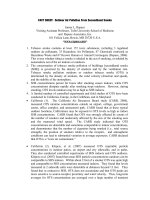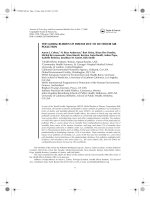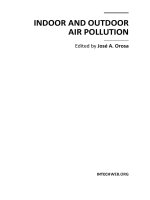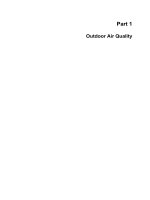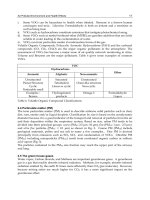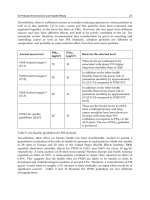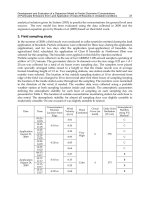Indoor and Outdoor Air Pollution Part 14 ppt
Bạn đang xem bản rút gọn của tài liệu. Xem và tải ngay bản đầy đủ của tài liệu tại đây (187.34 KB, 6 trang )
Air Quality Degradation: Can Economics Help in Measuring its
Welfare Effects?A Review of Economic Valuation Studies
121
Authors Study Area
Valuation
Technique
Environmental Impact /
Good to be Valued
Results
Li et al., (2004) Shnaghai
Cost Benefit
Analysis
Health benefits from
pollution reduction
Benefit cost ratio
revealed considerable
net benefits to be
derived
Gupta, (2006) India
Cost of
illness
Monetary benefits to
individuals from
avoided health damages
due to reductions in air
pollution
Results indicated that
the mean worker from
Kanpur would gain Rs
165 per year if air
pollution were
reduced to a safe level
Welsch, (2006)
10
European
Countries
Life
satisfaction
approach
Effect of air pollution on
well- being
It was found that a
decrease in the NO
2
concentrations is
valued at $398 per
person per year in
Greece up to $1858 in
Luxembourg (in 1997).
Rabl, (1999) France
Damage
Cost
Ambient Air Pollution
and Historical Buildings
Analysis provides
estimates for the
damage cost of air
pollution on historical
buildings focusing on
the effects of acidic
deposition on
corrosion and
deposition of soiling.
Chilton et al.,
(2004)
UK
Contingent
Valuation
Health benefits of
improved air pollution
in terms of mortalit
y
and
morbidity
The mean annual
WTP for chronic
mortality is ₤ 29.52
for the one month
sample, ₤ 30.21 for the
three months sample
and ₤38.73 for the six
month sample.
Larson et al.,
(1999)
Russia
Value of a
Statistical
Life/Cost-
Benefit
Analysis
Particulate emissions
and mortality
Economic assessment
revealed a positive net
benefit of $40million
Damigos,
(2005)
Crete,
Greece
Damage
Costs
Air Pollution - energy
Environmental
improvement due to
reduced NOx
emissions calculated at
3.350.000 € per year
Indoor and Outdoor Air Pollution
122
Authors Study Area
Valuation
Technique
Environmental Impact /
Good to be Valued
Results
Aunan et al.,
(1998)
Hungary
Cost-Benefit
Analysis
Air Pollution and public
health, buildings
materials and
agricultural crops
Estimated annual
benefits of improved
health conditions
exceeds the
investments needed
Miraglia,
(2007)
Brazil
Cost-Benefit
Analysis
Air Pollution
Quantitative
environmental
analysis resulted in a
positive balance of
2851US$
Vrhovcak et
al., (2005)
Croatia Damage cost
External costs of
electricity generation in
terms of human health
Authors estimated
external cost for a
bundle of health
endpoints
Cesar et al.,
(2002)
Mexico
Dose –
response
functions/
Cost of
Illness
Health benefits from a
number of pollution
reduction scenarios
Results suggest that a
10% reduction in
ozone was about $760
million (in 1999 U.S.
dollars) annually and
the benefit for a 20%
reduction in ozone and
PM was about 1.49
billion annually.
Murty et al.
(2003)
Delhi and
Kolkata
Health
production
functions
and demand
functions for
avertin
g
and
mitigating
activities
Air pollution
Annual marginal
benefits to a typical
household ranged
from Rs 2086 in Delhi
to Rs 950 in Kolkata if
the level of SPM is
reduced from current
average level to the
prescribed safe level.
Komavora,
(2009)
Moscow
Hedonic
pricing
Relationship between air
pollution and housing
prices
Ecological variable had
a negative sign while
increasing the level of
air contamination from
carbon monoxide,
nitrogen dioxide,
sulphur dioxide and
particles.
MacMillan,
(1996)
Scotland
Contingent
Valuation
Effect of reduced acid
rain deposition in the
ecosystems
Average WTP ranged
from £247 to £351
depending on the
scenario
Air Quality Degradation: Can Economics Help in Measuring its
Welfare Effects?A Review of Economic Valuation Studies
123
Authors Study Area
Valuation
Technique
Environmental Impact /
Good to be Valued
Results
Pollicino &
Maddisson,
(2002)
Lincoln
Cathedral,
UK
Contingent
Valuation
Aesthetic changes on
historical buildings due
to air pollution
All studies produced
WTP estimates for a
policy option that
would reduce harmful
pollutants
Morey et al.,
(2002)
Washington
Contingent
Valuation
Acid deposition injuries
to marble monuments
Navrud &
Strand, (2002)
Nidaros
Cathedral,
Norway
Contingent
Valuation
Air pollution and
damages to buildings
Table 1. Summary of the Valuation Studies
7. References
Alberini, A.; Cropper, M.; Fu, T.T.; Krupnick, A.; Liu, J.T.; Shaw, D. & Harrington, W. (1997).
Valuing health effects of air pollution in Developing countries: the Taiwan
experience. Journal of Environmental Economics and Management, Vol. 34, pp. 107-26
Alberini, A. & Krupnick, A. (2000). Cost of Illness and Willingness to Pay estimates of the
Benefits of Improved Air Quality: Evidence from Taiwan. Journal of Land Economics,
Vol. 76, No.1, pp. 37-53
Arrow, K.; Solow, R.; Portney, P.R.; Leamer, E.E & Radner, R.H. (1993). Report on the
NOOA Panel on contingent valuations, natural resource damage assessment under
the oil pollution act of 1990. Federal Register, Vol. 58 pp. 4601-4614
Aunan, K.; Patzay, G.; Aaheim, H.A. & Seip, H.M. (1998). Health and Environmental
Benefits from Air Pollution Reductions in Hungary. The Science of the Total
Environment Vol. 212, pp. 245-268
Banfi, S.; Filippini, M. & Horehajova, A. (2007). Using a Choice Experiment to Estimate the
Benefits of a Reduction in Externalities in Urban Areas with Special Focus on
Electrosmog. Centre for Energy Policy and Economics (CEPE), Working Paper No. 57,
ETH (Swiss Federal Institute of Technology), Zurich
Bateman, I.; Carson, R.; Day, B.; Hanemann, M.; Hanley, N.; Hett, T.; Jones-Lee, M.; Loomes,
G.; Mourato, S.; Ozdemiroglu, E.; Pearce, D.; Sugden, R. & Swanson, J. (2002)
Economic Valuation with Stated Preferences Techniques: A manual. Cheltenham,
Edward Elgar, ISBN:9781840649192
Belhaj, M. (2003). Estimating the benefits of clean air; Contingent valuation and hedonic
price methods. International Journal of Global Environmental Issues, Vol. 3, No. 1, pp.
30-46
Bell, M.L.; Davis, D.L.; Cifuentes, L.A.; Krupnick, A.J; Morgenstern, R.D. & Thurston, G.D.
(2008). Ancillary human health benefits of improved air quality resulting from
climate change mitigation. Journal of Environmental Health Vol. 7, No. 41
Brucato, P.F.; Murdoch, J.C. & Thayer, M.A. (1990). Urban Air Quality Improvements: a
Comparison of Aggregate Health and Welfare Benefits to Hedonic Price
Differentials. Journal of Environmental Management Vol. 30, No. 3, pp. 265-279
Bonniex, F. & Rainelli, P. (1999). Contingent Valuation Methodology and the EU
institutional framework. In Bateman, I.J., Willis, K.G. (eds.) Valuing environmental
preferences, Theory and practice of the contingent valuation method in the US, EU and
Developing Countries. New York, Oxford University Press pp. 585-612
Indoor and Outdoor Air Pollution
124
CAFÉ (2005) Commission Staff Working Paper, Annex to: The Communication on Thematic
Strategy on Air Pollution, and the Directive on Ambient Air Quality and Cleaner
Air for Europe, SEC (2005) 1133
Carlsson, F. & Johansson-Stenman, O. (2000). Willingness to pay for improved air quality in
Sweden. Journal of Applied Economics Vol. 32, pp. 661-669
Cesar, H.; Borja-Aburto, V.H.; Dorland, K.; Munoz Cruz, R.; Brander, L.; Cropper, M.; et al.
(2002). Improving air quality in metropolitan Mexico City: an economic valuation,
Policy Research Working Paper Series 2785, The World Bank, Washington, DC
Chau, C.K.; Hui, W.K. & Tse, M.S. (2007). Evaluation of health benefits for improving indoor
air quality in workplace. Environment International, Vol. 33, No.2, pp. 186-198
Chestnut, L.G.; Ostro, B.D. & Vichit-Vadakan N. (1997). Transferability of Air Pollution
Control Health Benefits Estimates from the United States to Developing countries:
Evidence from the Bangkok study. American Journal of Agricultural Economics, Vol.
79, pp. 1630-1635
Chilton, S.; Covey, J.; Jones-Lee, M.; Loomes, G. & Metcalf, H. (2004). Valuation of health
benefits associated with reductions in air pollution, final report; Department for
Environment Food and Rural Affairs, London, UK.
EXTERNE (2005). Externalities of Energy. Methodology 2005 Update Bickel P. and Friedrich R.
(eds), European Commission, EUR 21951 ISBN 92-79-00423-9
Damigos, D. (2005). Economic aspects and environmental cross-media effects in energy
production. WSEAS Int. Conference: Energy, Environment, Ecosystems, Sustainable
Development, Vouliagmeni Greece, IASME Transactions Vol. 3, No. 2, pp. 325-330
Delucchi, M.A.; Murphy, J.J. & McCubbin, D.R. (2002). The health and visibility costs of air
pollution: a comparison of estimation methods. Journal of Environmental
Management Vol. 64 pp. 139-152
Desaigues, B; Rabl, A; Ami, D.; My, K.B.; Masson, S.; Salomon, M.A.& Santoni, L. (2004).
Monetary valuation of air pollution mortality: current Practice, Research Needs and
Lessons from a Contingent valuation. Universite de Strasbourg, Strasbourg, Alsace,
France
Dziegielewska, D. & Mendelsohn, R. (2005). Valuing air quality in Poland. Journal of
Environmental and Resources Economics, Vol. 30, No.2, pp. 131-163
Gupta, U. (2006). Valuation of urban air pollution: a case study of Kanpur in India. SANDEE
Working Paper No. 17-06, South Asian Network for Development and Environmental
Economics (SANDEE), Kathmandu, Nepal
Halvoren, B. (1996). Ordering effects in contingent valuation surveys: Willingness to pay for
reduced health damage from air pollution. Journal of Environmental and Resources
Economics, Vol. 8, pp. 485-99
Hammit, J. K. (2002). QALYs vs WTP. Journal of Risk Analysis, Vol. 22, No.5, pp. 985-1001
Hammit, J.K. & Zhou, Y. (2006). The economic value of air pollution related health risks in
China: a contingent valuation study. Journal of Environmental and Resource
Economics, Vol. 33, No. 3, pp. 399-423
Hubbell, B.J. (2006). Implementing QALYs in the Analysis of Air Pollution Regulations.
Journal of Environmental and resources Economics, Vol. 34, No. 3, pp. 365-384
Karousakis, K. & Koundouri, P. (2006). A Typology of Economic Instruments and Methods
for Efficient Water Resources Management in Arid and Semi-Arid Regions, in
Water Management in Arid and Semi-Aid Regions: Interdisciplinary Perspectives.
Edward-Elgar Publishing, p. 161-187
Katsouyanni, K. (2003). Ambient air pollution and health. British Medical Bulletin Vol. 68, No.
1, pp. 143-156
Air Quality Degradation: Can Economics Help in Measuring its
Welfare Effects?A Review of Economic Valuation Studies
125
Komavora, V. (2009). Valuing Envirnmental Impact of Air Pollution in Moscow with
Hedonic Prices. World Academy of Science, Engineering and Technology, Vol. 7, pp.
319-326
Krupnick, A.; Alberini, A.; Cropper, M.; Simon, N.; O’Brien, B.; Ron Goeree, R. &
Heintzelman, M. (2002). Age, Health and the Willingness to Pay for Mortality Risks
reductions: A Contingent Valuation Survey of Ontario Residents. Journal of Risk and
Uncertainty Vol. 24, No. 2, pp. 161-186
Kuik, O.; Navrud, S. & Pearce, D.W. (1992). Benefit estimation and environmental decision
making. In Navrud S. (eds), Pricing the European Environment, Oslo, Scandinavian
University Press
Larson, B.A.; Avaliani, S.; Golub, A.; Rosen, S.; Shaposhnikov, D.; Strukova, E.; Vincent, J.R.
& Wolff, S.K. (1999). The economics of air pollution health risks in Russia: a case
study of Volgograd. World Development Vol. 27, No.10, pp. 1803-1819
Li, J.; Guttikunda, S.K.; Carmichael, G.R; Streets, D.G; Chang, Y-S. & Fung, V. (2004).
Quantifying the human health benefits of curbing air pollution in Shanghai. Journal
of Environmental Management Vol. 70, No.1, pp. 49-62
Macmillan, D.; Hanley, N. & Buckland, S. (1996). A Contingent Valuation Study of
Uncertain Environmental Gains. Scottish Journal of Political Economy, Vol. 43, No. 5,
pp. 519-533.
MacMillan, D. (2001) Valuation of Air Pollution Effects on Ecosystems: A Scoping study. A
report prepared to the Department for Environment, Food and Rural Affairs. University
of Aberdeen
Miraglia, S.G.E.K. (2007). Health, environmental and economic costs from the use of a
stabilized diesel/ethanol mixture in the city of Sao Paolo. Cadernos de saude publica
Vol. 23, pp. 559-569
Mitchell, R.C & Carson, R. (1989). Using Surveys to Value Public Goods: The Contingent
Valuation Method. Resources for the Future, Washington, D.C.
Morey, E.R.; Rossmann, K.G.; Chestnut, L.G. & Ragland S. (2002). Valuing Reduced Acid
Deposition Injuries to Cultural Resources: Marble Monuments in Washington, D.C.
In Valuing Cultural Heritage: applying environmental techniques to historic buildings,
monuments and artifacts,, Navrud, S. & Ready, R.C. (eds.) Cheltenham: Edward
Elgar Publishing Limited, UK
Murty, M.N.; Gulati, S.C. & Banerjee A. (2003). Health Benefits from Urban Air Pollution
Abatement in the Indian Subcontinent. E/236/2003, Delhi: Institute of Economic
Growth
Navrud, S. (2001).Valuing health impacts from air pollution in Europe. Journal of
Environmental and Resources Economics, Vol. 20, No.4, pp. 305-329
Navrud, S. & Strand, J. (2002). Social Costs and Benefits of Preserving and Restorig Nidaros
Cathedral. In Valuing Cultural Heritage: applying environmental techniques to historic
buildings, monuments and artifacts, Navrud, S. and Ready, R.C. (eds) pp. 31-39,
Chentlenham: Edward Elgar Publishing Limited, UK, ISBN 1 84064 079 0
Navrud, S. (2004). Value transfer and environmental policy. In The International Yearbook of
Environmental and Resources Economics 2004/2005: a survey of current issues
Tietenberg, T and Folmer H. (eds.) Chapter 5, pp. 189-217 Edward Elgar Publishing,
Cheltenham, UK and Northampton, MA, USA.
Pearce, D. (1996). Economic Valuation and Health Damage from Air Pollution in the
Developing World. Energy Policy Vol. 24, No. 7, pp. 627-630.
Pearce D. (2001) Annex II: Integrating cost-benefit analysis into the policy process in
Howarth, A., Pearce D.W., Ozdemiroglu, E., Seccombe-Hett, T., Wieringa, K.,
Indoor and Outdoor Air Pollution
126
Streefkerk, C.M. de Hollander, A.E.M, RIVM report 481 505 024 Valuing the benefits
of environmental policy: The Netherlands, Bilthhover, RIVM.
Pearce D.W. and Ozdemiroglu, E et al. (2002) Economic Valuation with Stated Preference
Techniques. Summary Guide. Department for Transport, Local Government and the
Regions: London, UK
Pollicino, M. & Madisson, D. (2002). Valuing the Impacts of Air Pollution on Lincoln
Cathedral. In Valuing Cultural Heritage: applying environmental techniques to historic
buildings, monuments and artifacts. Navrud, S. and Ready, R.C. (eds) Chentlenham:
Edward Elgar Publishing Limited
Rabl, A. (1999). Air pollution and Buildings: an Estimation of Damage Costs in France.
Environmental Impact Assessment Review, Vol. 19, No. 4, pp. 361-385
Remoundou, K. & Koundouri P. (2009). Environmental effects on public health: An
economic perspective. International Journal of Environmental Research and Public
Health, Vol.6, No.8, pp. 2160-2178
Ridker, R.G. & Henning J. A. (1967). The determinants of residential property values with
special reference to air pollution. The Review of Economic and Statistics, Vol. 49, No. 2,
pp. 246-257
Smith, V.K & Huang, J-C. (1995) Can Markets Value Air Quality? A Meta-Analysis of Hedonic
Property Value Models. The Journal of Political Economy Vol. 103, No.1, pp. 209-227
Rodriguez, V. M. & Leon, C. (2004). Altruism and the Economic Values of Environmental
and Social Policies. Journal of Environmental and Resources Economics, Vol. 28, No.2,
pp. 233-249.
Rosenber, R.S & Loomis J.B. (2001). Benefit transfer of outdoor recreation use values: A
technical document supporting the Forest Service Strategy Plan (2000 revision).
RMRS-GTR-72, Fort Collins, CO: U.S. Department of Agriculture, Forest service, Rocky
Mountain Research Station
Vrhovcak, M.B.; Zeljiko, T. & Debrecin, N. (2005). External costs of electricity production:
case study Croatia. Energy Policy, Vol. 33, No.11, pp. 1385-1395
Wagstaff, A. (1991). Health Care: QALYs and the equity-efficiency tradeoff. Journal of Health
Economics. Vol. 10, pp. 21-41
Wang, H. & Mullahy, J. (2006). Willingness to pay for reducing fatal risk by improving air
quality: a contingent valuation study in Chongqing, China. Science of the Total
Environment Vol. 367, No.1, pp. 50-57
Wang, Y. & Zhang, Y-S. (2009). Air quality assessment by contingent valuation in Ji’nan,
China. Journal of Environmental Management, Vol. 90, No. 2, pp. 1022-1029
Welsch, H. (2006). Environment and happiness: Valuation of air pollution using life
satisfaction data. Ecological Economics, Vol. 58, No.4, pp. 801-813
Won Kim, C.; Phipps, T.T. & Anselin, L. (2003). Measuring the Benefits of Air quality
improvement: a spatial hedonic approach. Journal of Environmental Economics and
Management, Vol. 45, No. 1, pp. 24-39
Yoo, S.H.; Kwak, S.J. & Lee J.S. (2008). Using a choice experiment to measure the
environmental costs of air pollution impacts in Seoul. Journal of Environmental
Management, Vol.86, No. 1, pp. 308-318

